DRAMATIS PERSONAE: YOU AND I
CHORUS: all singing, all dancing
forays into the world and back again; 1stly, a single gesture opens up the space of commentary inviting the incidental live onstage. Two. a drafterly undercurrent streams thought to words and 3, well 3 is a dark work in the wings, lightningscript and love at first sight.
_____________________________________________________________________________________________
PROLOGUE
Before the making and delivery and making of work. You and I. Before we know what we are doing is any kind of work.
so OK ok
what?
It is ‘across speak’. Already.
And wayward.
let's make A start
with fundamentals - dialogue
(this '''''being with'''''')
- in dialogue
(It has to be has to be)
so what is it
any ways
It is dialogue noun 1 (dia) through --- plus --- (logos) word, speech –
and?
2 flowing-through meaning
and
3 listening & understanding
amongst other things
amongst other things
{Blind referee:
at its heart is
a good
narrative}
FULL STOP.
This recitation –
what a bout recitation?
– begins with Martina Copley’s exhibition ‘The movement of the aside’

— and an invitation to respond.
a sort of
A Sort Of
intellectual
spooning
Bracket
in the platonic
intellectual
sense of
the word
not other
Close Bracket
It arises out of research into Paul Carter’s notion of material thinking and collaborative practices and what it means to practice writing or something other (2004).
roundness
the mind
is with
one thing
different ways
we r
balancing
transfering weight
side to side
following
^smart phone
monastic story
It is dialogue as double act.
It is only through the process or what she calls ‘tissue’ of composition, Barb Bolt would say, that any understanding of the world can be made (2006: 1).
It is in practising we become multiple,
in the doing of it.
Process is crucial here, and music. It is in Hélène Cixous’ words, ‘a way of hearing another voice other than mine. And immediately the dialogue starts. It’s very musical’ (2004: 116).
.
.
.
.
.
.
.
.
.
.
.
.
.
.
ting. ting.
. ting. .humm
hm mm
{Blind referee:
but they expect
the reader to
do a lot of
work to find
it}
speaking in languages of instantaneous origin
[ bike bell mantra for the way home ]
This ‘across speak’ sounding emerges out of a set of experiments.
>PAUSE< [READ THIS]
1) A SINGLE GESTURE OPENS UP THE SPACE
The first experiment is a parsing exercise –
It’s like that
It’s lime that
Being. And present participles. Looking at the exhibition, experiencing the work, writing ‘Notes to M’ on an iPhone while she (is) sipping coffee. It is intense. There isn’t a lot of time. It is unrehearsed.
How do you know i was there?
This floor needs sweeping
It is thinking as thinking, in other words, not representational processes but ‘thinking in action’ made concrete in poetic notes – thinking as the thing itself as thinking is happening. Now.
1. pull out safety pin
2. aim at fire – squeeze handles
It is method is in the making: being with and responding to as creative method.
I look
I air
Immersion. And patience.
If I had a dictionary. If we had plasticine.
If we could dance. Oh if we could fly.
{Blind referee
as aside: the
writing isn’t
really good
enough (fresh,
innovative
}
It is poetics, made material, engages word, world, work … line break and punctuation:/+?”’
Across speak is a finding form and a furthering. All furthering is liminal
2) A DRAFTERLY UNDERCURRENT
The second experiment, something we call in the beginning – roughly – ‘m and me :: I and u’ – morphs into an artist’s book called No Notes (This is writing).
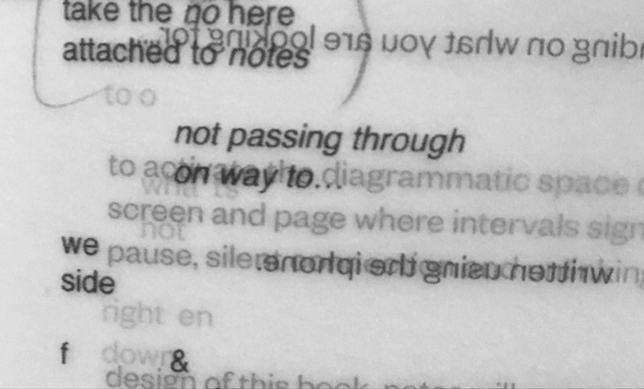
No Notes is an open-ended ‘across speak’ between two artists, made over seven months on iPhones (texting text back and forth through iNotes), something that unfolds as process – of unfolding. The limited edition, 152-page publication is pocket-sized like the iPhone on which it was written.
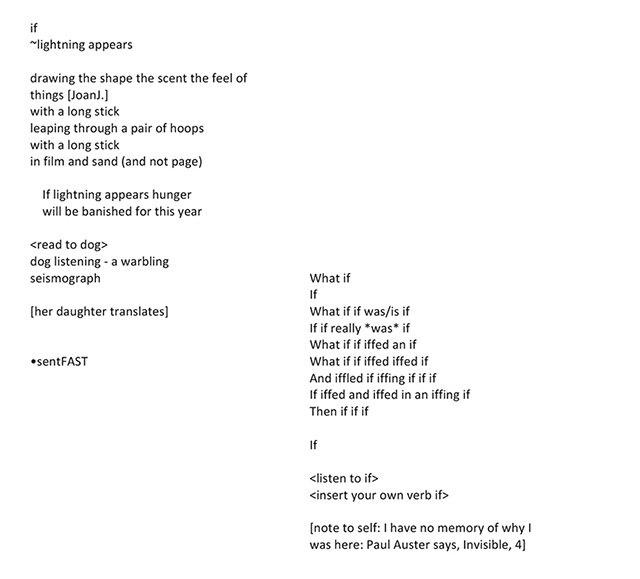
No Notes can be intimately browsed like a book of poetry.
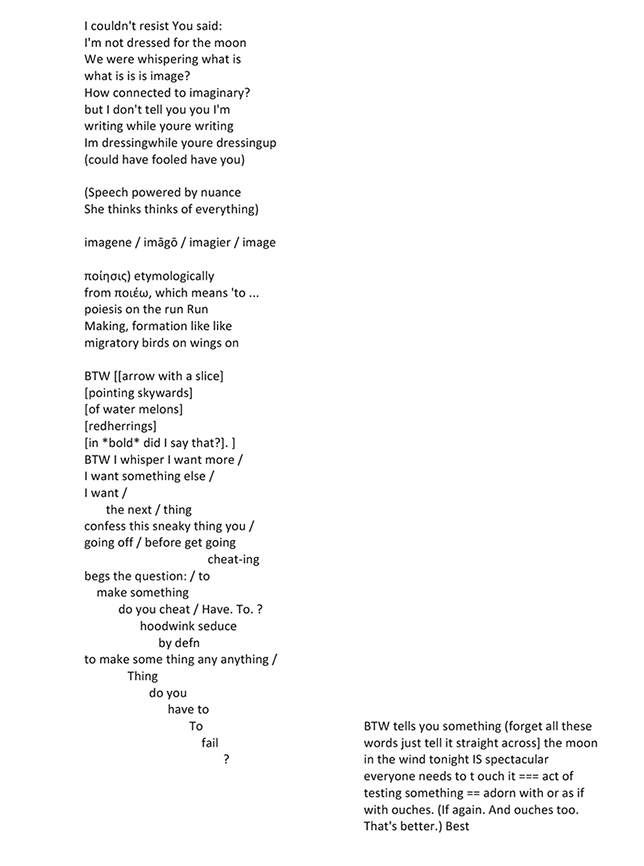
Its collaborative, draft-like nature allows for spontaneity and engagement. It demands openness to the practice of the other and to a responsive working method with uncertain outcome. Working within constraints. Forces new approaches.
of unfolding or ‘across speak’
riddled with
written to one another –
(almost as if inner voice spoken out loud)
poetic notes.
It is – opening ourselves to the possibility of love by acting in such a way so that the experience of love and this across speak can only be made possible by knowledge that there is such a thing – simply by coming in close proximity and allowing love to happen.
to aside as a verb
to verb to across speak
to allow something else to occur
to listen to the music
[ . . . ] It is a public oratorio. Entry and exits.
stepping off points
I really like
are the public readings
Sound as drawing.
ivebeen trying to remember last time we read, thinking one page of
text will make the reading too short? Did we do two pages per
sheet, were they double sided? What do you think?
Sent from my iPhone
and the way it is hard now to know who wrote what
{Blind: in
short, I find
it a bit
incoherent}
are the misspellings which remain as spacings and stutters in the
text – disruptions that have their own flow
It is across speak riddled with surprise, pleasure, invigoration as well as doubt, desire and struggle.
and move attention to how language is being used.
transitions, lapses
hesitations
the space-time between frames
pauses between
latent images, slow dissolves
that is sometimes empty space
a creative anticipation, prospective time,
<unfiguring in terms of the unforeseen>
{Blind Referee aside:
but it has
sufficient
attractive
features}
3) A DRAFTERLY UNDERCURRENT
Experiment number 3 is performed through the post and with a photocopier. Called Song, Sender, X, (including commas) we post each other back and forth: paper and feathers and material and needles, string and cotton and words and scribbles. With hearts.
X,
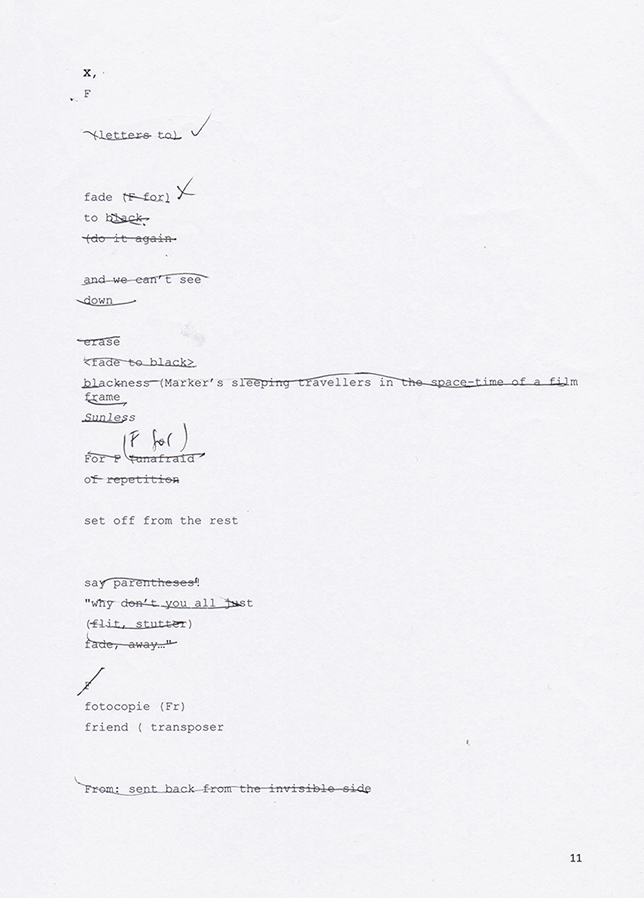
F
fotocopie (Fr)
friend ( transposer
From: sent back from the invisible side
dearfelt
for
too
song
,end fragment>
Here, it is all just-a-great feeling and non-speaking to make them together. It is gesture and call-and-response, breathing and texture and light. Hands. Fingers. At work.
{: surprise
arises}
worried
somewhat
about our project
and I’m not sure I can se it
any ideas?
I cant settle on anything
Actually I don’t know what it means in concrete terms but I’m super
into it.
It is across speak or dialogue not from an outside but from inhabiting the space of being with the other that these bodies between allow, this body that is being with.
work (love). how to do it.
<note the difficulty> she said.
“three easy steps”
{Aside from blind referee :
a graphical and
visual
intelligence on
show}
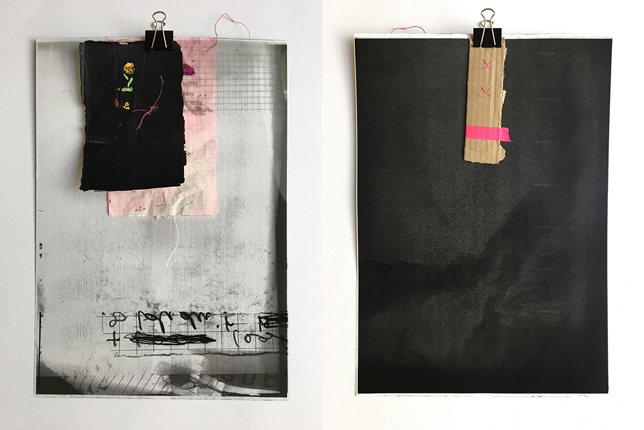
Voice-over
And image collage

Not knowing involves a recognition that you somehow already know but
don’t know that or how you know
{: a good
understanding
of the
generative
affordances of
associative
techniques such
as collage,
montage, super-
imposition,
dubbing}
Making work we are already there. we just have to find our way back.
{enlightening
play}
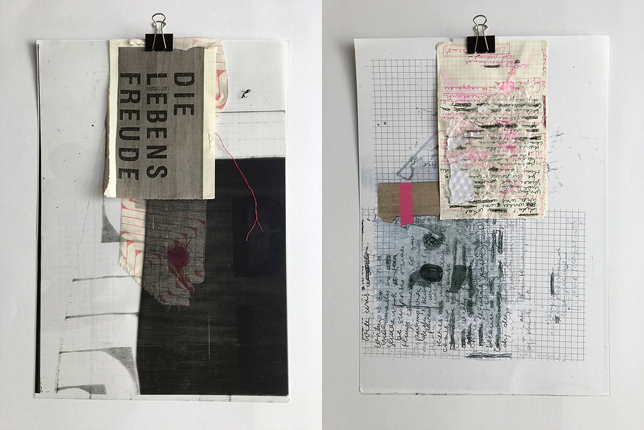
I have a good feeling about this too.
{Blind aside:::
alteration a
love
experienced in
association
with the loved
one is
comparable to
the alchemy of
montage/dubbing
etc}
CODA OR TAIL
How do we end? In silence? Negative space? A square bracket and comma – [ ,? (Rice 2017)
In the gaps, between, this being the last (w)hole?
{: after some
sharpening up}
It’s awkward coming down.
Or thinking/acting out ma (the Japanese word for spacebetween, spacing, interval, gap, blank, room, rest, time, timing, opening) ... Pause, incompleteness, an unfinished thing, a non-narrative, ending-beginning – at the same time
a poetic movement shows itself
Notes
This three-act structured recitation with prologue and coda addresses both breach and connection. Martina Copley and Francesca Rendle-Short are in conversation/dialogue across speak ~ three experiments in material poetics:
- Copley’s exhibition, The movement of the aside (Victorian College of the Arts Gallery, 2015) and Rendle-Short’s Notes to M in ‘Parsing the aside (the poetics of immersion and patience as dialogue)’ (Creative Writing as Research IV, TEXT Journal Special Issue, Number 30, October 2015)
- No Notes (This is Writing), Martina Copley and Francesca Rendle-Short, limited edition publication, 2017 (Poetry, George Paton, 4-13 October 2017)
- Song, Sender, X, 2017, Martina Copley and Francesca Rendle-Short (BLINDSIDE, B – Side, 3-10 November 2017)
‘Across speak’ follows on from previous writing/art experiments to argue that it is only through process or ‘tissue’ of composition (Bolt 2006) that any understanding of the world can be made. Collaborative dialogue or ‘across speak’ happens in the making, present tense; in the back-and-forth, the now. It is the result of the interplay of intelligences: the artist/s at work, the materials at hand, the process and interrogation of making itself. It is playful, unrehearsed, drafterly, and wayward. Allowable and possible through and because of close proximities and distances.
‘Across speak’ explores the material poetics of breach and connection by threading together three stand-alone works. Through immersion and patience and a kind of being with, it makes a case for finding form and the liminality of making. It invites the reader to foray with the author/artists into the worlds they have created and back again through gesture, commentary, soundings, asides, incidentals, doubt, and the possibility of flight and love.
‘Across speak and/or waywardness’ tests the extent and limits of process as creative method when artists come together in dialogue and collaboration. It elevates music in the making: it unfolds a way of hearing the Other, of connecting and ‘being with’ across space and time, of composing the present tense, of allowing thinking/making as thinking/making to actually become the thing.
Keywords: Experiment — process — collaboration — creative methods — technology — poetics
Bolt, B 2006 ‘Materializing pedagogies’, Working Papers in Art and Design 4, at
http://sitem.herts.ac.uk/artdes_research/papers/wpades/vol4/bbfull.html (accessed 28 January 2018)
Carter, P 2004 Material thinking: The theory and practice of creative research, Melbourne: Melbourne University Publishing
Cixous, H 2004 The writing notebooks of Hélène Cixous (ed Susan Sellers), New York: Continuum
Rice, S 2017 ‘Creative In-formation — a Per-formance or possibly a list poem — does it matter? Back to the drawing board’, TEXT Special Issue 40, April, at http://www.textjournal.com.au/speciss/issue40/Rice.pdf (accessed 7 April 2018)